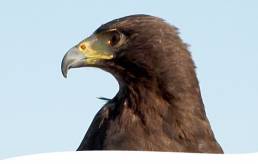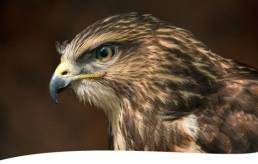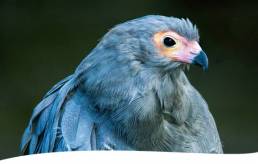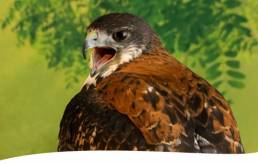Hawks & Buzzards
Hawks and Buzzards are a vast species from the birds of prey family and are widely distributed across the globe.
They are generally known as medium-sized birds of prey that hunt diurnally and often referred to as the ‘broad-wings’ due to the shape of their wing and tail. Falconry is often referred to as ‘hawking’ as hawks and buzzards are used instead of Falcons, as they can catch larger prey. Here at Gauntlet we have five species of Hawks and Buzzards. If you want to get a feel for falconry, we take you out for a hawk walk in a number of our birds of prey experiences. You’ll get to handle some of our hawks and see them in action – working together and flying free!

Harris Hawk
Harris Hawks live in groups and are known as “the wolves of the sky”.
LATIN NAME: Parabuteo unicintus
DISTRIBUTION: Central and South America
HABITAT: Open country, typically drier regions
DIET: Mammals to size of rabbits, also some birds, lizards and insects
WINGSPAN: 90–120cm

Red-tailed Hawk
The Red-tailed Hawk can crush sandstone with its feet.
LATIN NAME: Buteo jamaicesis
DISTRIBUTION: North and Central America, Caribbean
HABITAT: Wide ranging – dense forest to sparse woodland, prairies, grassland and deserts
DIET: Mainly mammals
WINGSPAN: 105–140cm

Common Buzzard
The Common Buzzard is the largest native bird of prey in England.
LATIN NAME: Buteo buteo
DISTRIBUTION: Europe and Russia
HABITAT: Open country and woodland areas
DIET: Mammals to size of rabbits, also some birds, lizards and amphibians
WINGSPAN: 110–140cm

African Harrier Hawk
The African Harrier Hawk is also known as Gymnogene.
LATIN NAME: Polyboroides typus
DISTRIBUTION: Sub-Saharan Africa
HABITAT: Forest, woodland, savannah and thornbush
DIET: Diverse – Insects, eggs, young birds and small invertebrates
WINGSPAN: 120–150cm

Argentinian Red-backed Hawk
This bird is also called the ‘variable hawk’ due to the large variants found in its colour morph, size and habitat.
LATIN NAME: Geranoaetus polyosoma
DISTRIBUTION: Western and southern South America, including the Falkland Islands
HABITAT: Above tree line in mountains, Pacific coastal foothills, agricultural areas, beech woods and lowland forests
DIET: Rabbits, earthworms, weevils, other invertebrates and some birds, other prey include rodents, frogs, lizards, snakes and fish
WINGSPAN: 113–151cm

